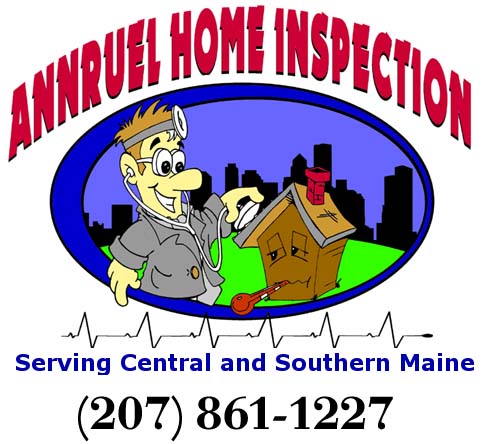Copyright 2016 James MacNaughton DBA AnnRuel Home Inspections 11 Church st Oakland, Maine (207) 861-1227
SERVICE AREA INCLUDES BUT IS NOT LIMITED TO... Albion Augusta Auburn Bangor Belgrade Belgrade Lakes Bowdoin Bowdoinham Bruinswick Burnham Canaan Cape Elizabeth Chelsea China Clinton Cornville Cumberland Detroit Dresden Durham Fairfield Farmingdale Fayette Falmouth Freeport Gardiner Gray Greene Hallowell Hartland Kents Hill Lewiston Lisbon Madison Manchester Monmouth Mount Vernon Newport New Gloucester Norridgewock Oakland Palermo Poland Portland Pittston Pittsfield Readfield Richmond Rome Sidney South Portland Skowhegan Somerville Smithfield St Albans TroyUnity Vassalboro Vienna Waterville Wayne Westbrook Whitefield Windsor Winslow Windham Winthrop









Nachi Certified Home Inspector
SEPTIC INSPECTION


1) A search of the Town municipal records for a copy of the sub-surface waste-water disposal permit (HHE-200 form), certificate of approval, ect. A review of Town records and/or real estate disclosure statement for declaration of number of bedrooms and septic site condition, recorded use of dwelling (i.e. seasonal/year-round)
2) Internal Review/Plumbing Connections
3)Verification of laundry system hook-up to sanitary septic system ? Identification of water treatment system, etc., and disposal method for disclosure ? If pump station utilized, proper identification of separate pump electrical circuit and high water alarm
4) Locate and inspect the septic tank with observation and if easily accessible the outlet baffle to record and report sludge/scum build-up, integrity of baffle, working liquid capacity, general integrity of tank size, type, existence or lack of risers and covers if required. Only done if the cover is less then 14 inches from the surface
5) Field inspection and walk over/around property for observation of septic system breakout.
Classification/Conclusion The septic system inspection shall culminate in a basic written report of the conditions observed of the septic system components. Ties to septic tank should be included.
The inspection is completed by an individual who has attended a voluntary certification program established by the Maine Department of Human Services in cooperation with the Maine Department of Environmental Protection. The process includes a search of property owner, municipal, and state records and a visit to the property. The inspection report may include additional information beyond the minimum requirements and is the property of the inspector and the client. Copies are not provided to the municipality or the state by the inspector.
Our Standard Septic Inspection
The above plus running a Septic camera to the D- Box if possible and checking house septic plumbing NOT always digging up the D-Box
THE AVERAGE LIFE OF A SEPTIC SYSTEM IS 25 YEARS
Ten Tips for Maintaining Your Septic System
1. Pump your septic tank every two to five years, depending how heavily the system is used. Insist that the pumper clean your septic tank through the manhole in the center of the top of your septic tank, rather than the inspection ports above the inlet and outlet baffles.
2. If you use a garbage grinder (a.k.a. "dispose-all"), pump your tank every year. Or, better yet, remove the garbage grinder and compost your kitchen scraps. Garbage grinder use leads to buildups of grease from meat scraps and bones, and insoluble vegetable solids such as cellulose.
3. Keep kitchen grease, such as bacon fat and deep fryer oil, out of your septic system. It is not broken down easily by your system, can clog your drain field, and can not be dissolved by any readily available solvent that is legal to introduce to ground water.
4. Space out laundry loads over the course of the week and wash only full loads. The average load of laundry uses 47 gallons of water. One load per day rather than 7 loads on Saturday makes a big difference to your septic system. Also, front loading washers use less water than top loading machines.
5. Install low usage water fixtures. By installing low water usage shower heads (2.5 gallons/minute), toilets (1.6 gallons), dishwashers (5.3 gallons) and washing machines (14 gallons) an average family can reduce the amount of water entering the septic system by 20,000 gallons per year! Low flow shower heads and toilets can be purchased at local lumber yards. Water saving dishwashers and washing machines can be purchased at better appliance stores.
6. Install a septic tank outlet filter in your tank. These generally sell for $100 to $200 depending upon brand and model. They catch small floating particles and lightweight solids, such as hair, before they can make it out to the disposal area and cause trouble. Some models are also designed to capture suspended grease.
7. Use liquid laundry detergent. Powered laundry detergents use clay as a "carrier." This clay can hasten the buildup of solids in the septic tank and potentially plug the disposal area.
8. Minimize the amount of household cleaners (bleach, harsh cleaners) and similar potentially toxic substances entering the septic system. Note: some substances are not allowed to be introduced into septic systems or ground water tables. If in doubt, contact your Local Plumbing Inspector or the Division for more information.
9. Do not use disinfect automatic toilet bowl cleaners, such as those containing bleach or acid compounds. The continuous slow release of these chemicals into the septic system kills the micro-organisms which treat your waste water.
10. You do not need to put special additives into your septic system. In fact, some can do more harm than good. Those which advertise that they will remove solids from your tank, usually do. The problem is that the solids exit the tank and end up in the disposal field. Once there, the solids seal off the disposal area, and the system malfunctions. Also, although it hurts nothing, it is not necessary to "seed" a new system with yeast, horse manure, and so forth. Normal human waste contains enough bacteria for the septic tank, and other microbes are already present in the soil and stones of the disposal area.
SYSTEMS WITHOUT RISERS AND OVER 14 INCHES BELOW THE SURFACE WILL REQUIRE FURTHER PAYMENT. $100 PER HOUR DIGGING
WHAT IS A SYSTEM INSPECTION
According to the State of Maine

Email: JamesRuelMac@gmail.com


